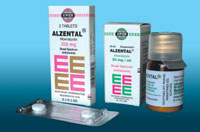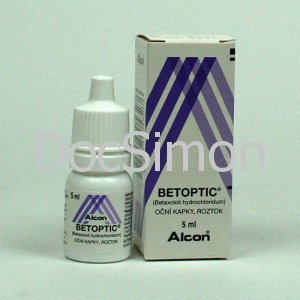COMPOSITION
1 mL of solution contains 5.45 mg moxifloxacin hydrochloride equivalent to 5 mg moxifloxacin base.
Excipients: Sodium chloride, boric acid, hydrochloric acid (E507) and/or sodium hydroxide (E524) (to adjust pH) and purified water.
PHARMACOLOGICAL CLASSIFICATION
A.15.1 Ophthalmic preparations with antibiotics and/or sulphonamides.
PHARMACOLOGICAL ACTION
Pharmacodynamic properties
Moxifloxacin is a fourth-generation fluoroquinolone antibacterial agent active against a broad spectrum of Gram-positive and Gram-negative ocular pathogens, atypical microorganisms and anaerobes.
Mechanisms of Action
Moxifloxacin has in vitro activity against a wide range of Gram-positive and Gram-negative microorganisms. Moxifloxacin inhibits the topoisomerase II (DNA gyrase) and topoisomerase IV required for bacterial DNA replication, transcription, repair, and recombination. The C8-methoxy moiety of moxifloxacin also lessens the selection of resistant mutants of Gram-positive bacteria.
Mechanism(s) of Resistance
In vitro resistance to moxifloxacin develops slowly via multiple-step mutations and occurs at a general frequency between 10-9 to 10-11 for Gram-positive bacteria. Fluoroquinolones, including moxifloxacin, differ in chemical structure and mode of action from beta-lactamantibiotics, macrolides and aminoglycosides, and therefore may be active against bacteria resistant to beta-lactam antibiotics, macrolides and aminoglycosides.
Breakpoints There are no official topical ophthalmic breakpoints for moxifloxacin and although systemic breakpoints have been used, their relevance to topical ophthalmic therapy is doubtful. The systemic breakpoint used for this antibiotic is S <2mg/L, R>4mg/L.
Susceptibility to Moxifloxacin
Commonly susceptible species (i.e., an MIC50 of <4 mg/L for at least 10 strains)
Aerobic Gram-positive micro-organisms:
Corynebacterium speciesStaphylococcus aureus*Staphylococcus epidermidis*Staphylococcus hominisStaphylococcus warneri*Streptococcus mitis Group*Streptococcus pneumoniae*Streptococcus viridans Group*Aerobic Gram-negative micro-organisms:
Acinetobacter species*Escherichia coliHaemophilus influenzae*Pseudomonas aeruginosaSerratia marcescensOther micro-organisms:
Chlamydia trachomatis*
Species for which acquired resistance may be a problem
Aerobic Gram-positive micro-organisms:
None
Aerobic Gram-negative micro-organisms:
None
Other micro-organisms:
None
Inherently resistant organisms
Aerobic Gram-positive micro-organisms:
None
Aerobic Gram-negative micro-organism:
None
Other micro-organisms:
None
*denotes those species which have been satisfactorily demonstrated in clinical studies in at least 10 patients.
VIGAMOX has been studied in patients from newborns to adults, including geriatric patients.
In four randomised, double-masked, multicentre, controlled clinical trialsin which patients were dosed 3 times a day for 4 days, VIGAMOX produced clinical cures in 80% to 94% of patients treated for bacterial conjunctivitis. Microbiological success rates for the eradication of the baseline pathogens ranged from 78% to 97%.
In paediatric patients from birth to one month of age, VIGAMOX produced clinical cure in 80% of patients with bacterial conjunctivitis. The microbiological success rate for the eradication of the baseline pathogens was 92%.
In a randomised, double-masked, multicentre, controlled clinical trial in which patients were dosed twice a day for 3 days, VIGAMOX produced clinical cure in 74% of patients treated for bacterial conjunctivitis. Microbiological success rate for the eradication of the baseline pathogens was 81%.
Pharmacokinetic properties
Following topical ocular administration of VIGAMOX, moxifloxacin was absorbed into the systemic circulation. Plasma concentrations of moxifloxacin were measured in 21 male and female subjects who received bilateral topical ocular doses of VIGAMOX 3 times a day for 4 days. The mean steady-state Cmax and AUC were 2.7 ng/mL and 41.9 ng·hr/mL, respectively. These exposure values are approximately 1,600 and 1,200 times lower than the mean Cmax and AUC reported after well-tolerated therapeutic 400 mg oral doses of moxifloxacin. The plasma half-life of moxifloxacin was estimated to be 13 hours.
Preclinical safety data
Carcinogenesis, Mutagenesis, Impairment of Fertility:
Long term studies in animals to determine the carcinogenic potential of moxifloxacin have not been performed. However, in an accelerated study with initiators and promoters, moxifloxacin was not carcinogenic following up to 38 weeks of oral dosing at 500 mg/kg/day.
Moxifloxacin was not mutagenic in four bacterial strains used in the Ames Salmonella reversion assay. As with other quinolones, the positive response observed with moxifloxacin in strain TA 102 using the same assay may be due to the inhibition of DNA gyrase. Moxifloxacin was not mutagenic in the CHO/HGPRT mammalian cell gene mutation assay. An equivocal result was obtained in the same assay when v79 cells were used. Moxifloxacin was clastogenic in the v79 chromosome aberration assay, but it did not induce unscheduled DNA synthesis in cultured rat hepatocytes. There was no evidence of genotoxicity in vivo in a micronucleus test or a dominant lethal test in mice. Moxifloxacin had no effect on fertility in male and female rats at oral doses as high as 500 mg/kg/day, approximately 21,700 times the highest recommended total daily human ophthalmic dose.
Teratogenic Effects
Moxifloxacin was not teratogenic when administered to pregnant rats during organogenesis at oral doses as high as 500 mg/kg/day (approximately 21,700 times the highest recommended total daily human ophthalmic dose); however, decreased foetal body weights and slightly delayed foetal skeletal development were observed. There was no evidence of teratogenicity when pregnant Cynomolgus monkeys were given oral doses as high as 100 mg/kg/day (approximately 4,300 times the highest recommended total daily human ophthalmic dose). An increased incidence of smaller foetuses was observed at 100 mg/kg/day.
INDICATIONS
VIGAMOX is indicated for the topical treatment of bacterial conjunctivitis caused by susceptible organisms. (See Pharmacological action, Pharmacodynamic properties for susceptibility to Moxifloxacin).
CONTRA-INDICATIONS
VIGAMOX is contra-indicated in patients with a history of hypersensitivity to moxifloxacin, to other quinolones, or to any of the excipients in this medication.
WARNINGS
Special warnings and precautions for use
In patients receiving systemically administered quinolones, serious and occasionally fatal hypersensitivity (anaphylactic) reactions have been reported, some following the first dose. Some reactions were accompanied by cardiovascular collapse, loss of consciousness, angioedema (including laryngeal, pharyngeal or facial oedema), airway obstruction, dyspnoea, urticaria, and itching.
If an allergic reaction to VIGAMOX occurs, discontinue use of the drug. Serious acute hypersensitivity reactions to moxifloxacin or any other product ingredient may require immediate emergency treatment. Oxygen and airway management should be administered as clinically indicated.
As with other anti-infectives, prolonged use may result in overgrowth of non-susceptible organisms, including fungi. If superinfection occurs, discontinue use and institute alternative therapy.
Patients should be advised not to wear contact lenses if they have signs and symptoms of a bacterial ocular infection.
Effects on ability to drive and use machines
As with any eye drops, temporary blurred vision or other visual disturbances may affect the ability to drive or use machines. If blurred vision occurs at instillation, the patient should wait until their vision clears before driving or using machinery.
INTERACTIONS
While drug-drug interaction studies have not been conducted with VIGAMOX, they have been performed with the oral product at much higher systemic exposures than are achieved by the topical ocular route. Unlike some other fluoroquinolones, no clinically significant drug-drug interactions between systemically administered moxifloxacin and itraconazole, theophylline, warfarin, digoxin, oral contraceptives, probenicid, ranitidine or glyburide have been observed. In vitro studies indicate that moxifloxacin does not inhibit CYP3A4, CYP2D6, CYP2C9, CYP2C19 or CYP1A2 indicating that moxifloxacin is unlikely to alter the pharmacokinetics of drugs metabolised by these cytochrome P450 isozymes.
PREGNANCY AND LACTATION
Pregnancy
Since there are no adequate and well-controlled studies in pregnant women, VIGAMOX should be used during pregnancy only if the potential benefit justifies the potential risk to the foetus.
Breast-feeding women
Moxifloxacin has not been measured in human milk, although it can be presumed to be excreted in human milk. Caution should be exercised when VIGAMOX is administered to a nursing mother.
DOSAGE AND DIRECTIONS FOR USE
Use in adults including the elderly
Instil one drop in the affected eye(s) 3 times a day for 4 days.
No overall differences in safety and effectiveness have been observed between elderly and other adult patients.
Use in children
VIGAMOX has been shown to be safe and effective in paediatric patients including neonates and can be used at the same dose as in adults. There is no evidence that the ophthalmic administration of VIGAMOX has any effect on weight bearing joints, even though oral administration of some quinolones has been shown to cause arthropathy in immature animals.
Use in hepatic and renal impairment
Pharmacokinetic parameters of oral moxifloxacin were not significantly altered in patients with mild to moderate hepatic insufficiency (Child Pugh Classes A and B).
Studies were not performed in patients with severe hepatic impairment (Child Pugh Class C). Because of the low systemic exposure by the topical route of administration, no dosage adjustment of VIGAMOX is needed in patients with hepatic impairment.
The pharmacokinetic parameters of oral moxifloxacin are not significantly altered by mild, moderate or severe renal impairment. No dosage adjustment of VIGAMOX is necessary in patients with renal impairment.
Method of administration
To prevent contamination of the dropper tip and solution, care must be taken not to touch the eyelids, surrounding areas or other surfaces with the dropper tip of the bottle.
SIDE EFFECTS AND SPECIAL PRECAUTIONS
Undesirable effects
In clinical studies involving 1060 subjects, VIGAMOX was administered twice or three times daily. No serious ophthalmic or systemic undesirable effects related to VIGAMOX were reported in clinical studies. The most frequently reported treatment-related undesirable effect was ocular discomfort (4.1%), which was mild in 95.3% of those subjects who experienced it. The discontinuation rate due to ocular discomfort was 0.1%.
The following undesirable effects assessed as definitely, probably or possibly related to treatment were reported during clinical trials with VIGAMOX. Their incidence was either common (1.0% to 10.0%; maximum observed actual incidence of 4.1%), or uncommon (0.1% to less than 1.0%). All other effects were single reports, of which none were serious and related.
Ocular effects
Common: ocular discomfort (burning or stinging upon instillation) and ocular pruritus.
Uncommon: ocular hyperaemia, dry eye and ocular pain.
Systemic effects
Body as a Whole
Uncommon: headache.
Special Senses
Uncommon: taste perversion altered, bitter or bad taste following instillation.
KNOWN SYMPTOMS OF OVERDOSAGE AND PARTICULARS OF ITS TREATMENT
The limited holding capacity of the conjunctival sac for ophthalmic products practically precludes any overdosing of VIGAMOX. Intoxication after inadvertent oral ingestion can also be ruled out.
IDENTIFICATION
VIGAMOX is a clear, greenish-yellow solution
PRESENTATION
DROP-TAINER® dispensing system consisting of a bottle with 5 mL fill and dispensing plug, both natural low density polyethylene, with a white polypropylene closure.
STORAGE INSTRUCTIONS
Discard four weeks after first opening.
Keep out of reach of children Do not store above 25°C



